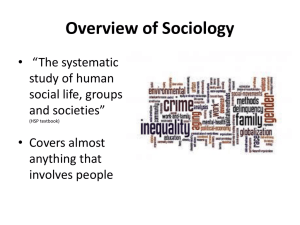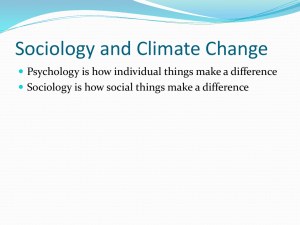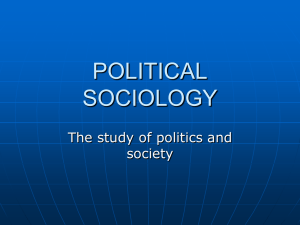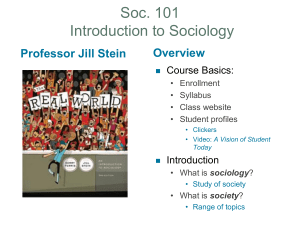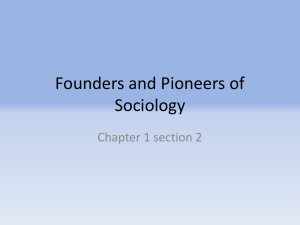Introduction to Sociology
advertisement
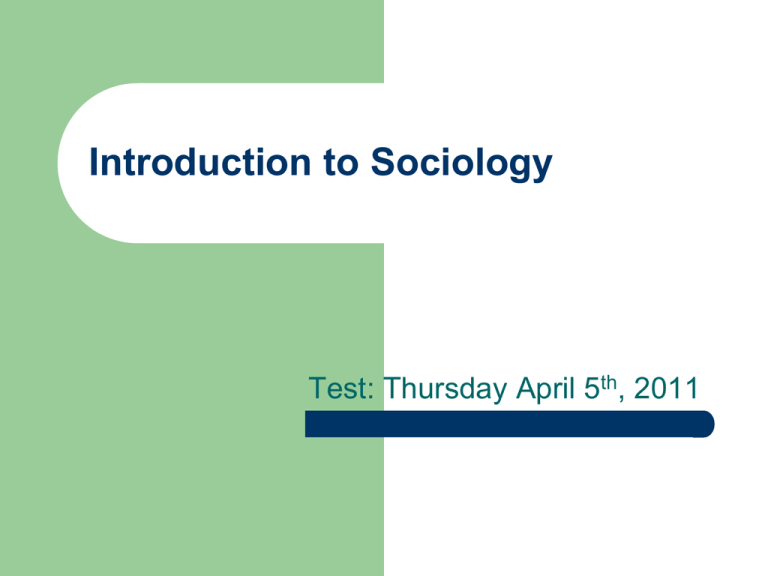
Introduction to Sociology Test: Thursday April 5th, 2011 Introduction to Sociology What is sociology? – The study of society & social behavior Seeks to understand how people interact & influence one another – Focus on groups rather than individuals Introduction to Sociology What is sociology? – Analysis is of a social fact (more men than women hold management positions despite equal opportunities) Something external & persuasive to social actors(men & women) Two types – Material: tangible, more apparent (pregnancy prevents promotion) – Non-material: intangible, more profound (golf) Provide 1. General enlightenment 2. Challenge of popular misconceptions 3. Identification for social problems 4. Solutions to social problems Introduction to Sociology What is sociology? – To effectively analyze a social fact sociologists must adopt: 1. Sociological Perspective/Imagination – Looking beyond commonly held beliefs to the hidden meaning behind human actions – Seeing the connection between the larger world & our personal lives Introduction to Sociology What is sociology? – True/False (explain your response) More US students are killed in school shootings now than 10-15 years ago. It is more dangerous to walk near topless bars than fast food restaurants. Most people on welfare are lazy & looking for a handout. They could work if they wanted to. Introduction to Sociology What is sociology? – True/False (explain your response) More US students are killed in school shootings now than 10-15 years ago. – – It is more dangerous to walk near topless bars than fast food restaurants. – False: National School Safety Center Study Media & Headlines would have us believe otherwise False: Private security at topless bars curb potential crime Most people on welfare are lazy & looking for a handout. They could work if they wanted to – False: 80% of the people on welfare are too young to work, too old to work, or work at least half the year (Henslin, 2008) Introduction to Sociology What is sociology? – Application: 1. Why do drug dealers (social actor) live with their mothers (social fact)? 2. With the crime rate (social actor) in the US growing exponentially during the 70s and 80s, and experts saying things were going to get much worse in the 1990s and beyond, the crime rates dropped dramatically (social fact). Why? – Choose one of the above questions and apply sociological imagination and perspective (not the internet) to identify an answer. Responses should be a minimum of 1/2 page. Introduction to Sociology Where/When/Why did the study of society develop? – 1700s & 1800s were a time of radical revolutions – What were some radical revolutions of that time period? Encouraged curiosity of social life & human interaction Introduction to Sociology Where/When/Why did the study of society develop? – Three Events Industrial Revolution – People flocked to cities creating modern urbanization problems – Instead of working for themselves people worked for employers Political Revolution – American (1776) &French (1789) created cultural, political, & economic chaos Enlightenment – Revolution in science to make the world a better place Introduction to Sociology Where/When/Why did the study of society develop? – Fathers of Sociology Auguste Comte (1798-1857): “Father of Sociology” First person to use the term “sociology” – Soc. would reform society making it a better place to live – Introduction to Sociology Where/When/Why did the study of society develop? – Fathers of Sociology Herbert Spencer (1820-1903): applied Darwin’s theory of survival of the fittest to society (Social Darwinism) – Society is an organism – Natural law is social law Who liked this theory? Why? Introduction to Sociology Where/When/Why did the study of society develop? – Fathers of Sociology Karl Marx: believed the world was made up of class struggles between working class & capitalist class – Capitalism is so bad that revolution is unavoidable Introduction to Sociology Where/When/Why did the study of society develop? – Fathers of Sociology Max Weber: focused on groups within society rather than society as a whole – Verstehen: understand feelings & motivations of human behavior – Catholics, Protestants, & emergence of capitalism Introduction to Sociology Where/When/Why did the study of society develop? – Fathers of Sociology Emile Durkheim: conducted the first sociological experiment Introduction to Sociology The first sociological experiment – List 3-5 reasons why a person might seriously consider suicide. Introduction to Sociology The first sociological experiment – Why is the rate of suicide higher in California higher than it is in Minnesota? Introduction to Sociology The first sociological experiment – Prior to Durkheim’s study, suicide was believed to be solely a individual/psychosocial/internal Using sociological perspective & imagination Durkheim concluded there are four types of suicide, based on social forces Introduction to Sociology The first sociological experiment – – – 1. Altruistic: motivated by self sacrifice for person, group, or cause (more common in tight communities i.e. Japan) 2. Fatalistic: miserable situation with no hope of getting out (i.e. to slaves suicide could be an escape) 3. Egoistic: High occurrence in those who are socially isolated (murder suicide, typically violent) unmarried, less constrained by social norms & goals – 4. Anomic: Created through difficulty with any amount of change (conflict of societal & individual goals) Social groups are affected by these factors at different rates Introduction to Sociology The first sociological experiment – Revolutionary findings created an opening for various sociological perspectives to gain credibility Human behavior cannot be understood individually Examine social forces that affect people’s lives Introduction to Sociology Modern Sociological Theories – Three main perspectives Each presents a slightly different image of society & focuses on different aspects of social life Certain consequences result from using a particular model Introduction to Sociology Modern Sociological Theories – Functionalism (Macro) Society is composed of structures and every structure has a function – Parallel between living body and society Manifest: intended function/action Latent: unintended and positive outcome Dysfunction: unintended and negative Example: School Introduction to Sociology Modern Sociological Theories – Conflict Theory (Macro) Opposite of functionalism Focus on negatives that arise as a result of divisions Poverty, drug use, race etc. – Conflict between the haves & have nots – Conflict will ultimately lead to social change http://www.youtube.com/watch?v=yyMLgOoUWpw&NR=1 Introduction to Sociology Modern Sociological Theories – Symbolic Interactionism (Micro Perspective) Interaction between people that take place through the use of symbols Introduction to Sociology Modern Sociological Theories – Mead’s Theory of Development of Self Not born with mind Mind is something developed – Three Stages Introduction to Sociology Modern Sociological Theories – Mead’s Theory of Development of Self 3 Stages – 1. Imitative Very early childhood Infant is not a social being Primarily aware of its own existence Can imitate symbols around with no attached meaning Example: Nephew imitating animal noises with no attached meaning Introduction to Sociology Modern Sociological Theories – Mead’s Theory of Development of Self 3 Stages – 2. Play Attached meaning to symbols Significant aspect of development Can anticipate behaviors and becomes aware of expectations Dogs and cats are at this level Example: Nephew recognizing image of animal a attaching correct sound Introduction to Sociology Modern Sociological Theories – Mead’s Theory of Development of Self 3 Stages – 3. Game Person becomes expert at symbolic language/communication Awareness of broader social expectations This is when you are human and have a human mind Example: Freshman football player Introduction to Sociology Modern Sociological Theories – C.H. Cooley’s Looking Glass Self How you are is based on how you think other people see you – Three Stages Take people surrounding you, and objectively view/assess yourself Imagine their judgment of you (is this good or bad) Determine if you appear the way you want (change behavior depending on how you think you appear) Example: Yesterday’s class Introduction to Sociology Modern Sociological Theories – Goffman’s Dramaturgy Theory When you are in the presence of another person you are acting Growing up is simply learning how to act – You do not have a self, self arises from the situation – You are a collection of characters that you play Example: living in Bigfork Introduction to Sociology Modern Sociological Theories – Exchange Theory—George Homans Everything is a mathematical process, awards and punishments are solutions to the process – Governs your actions Everyone is self centered, every action is done for self reward (not everyone has the same award system) Donald Trump and Mother Theresa have different reward system Example: Mr. Salzer as a child Introduction to Sociology What are the major aspects of your social life? Introduction to Sociology Modern Sociological Theories – Use one of the discussed modern sociological theories and apply it to one aspect of your social life Possible aspects of social life: – Internet Facebook Myspace Craigslist YouTube – Cellular Phones Texting Pictures Web access Introduction to Sociology Modern Sociological Theories – Use one of the discussed modern sociological theories and apply it to one aspect of social life Possible aspects of social life: – Entertainment TV Professional Sports – School – Extra Curriculars – Work Introduction to Sociology Culture – Accumulated body of society’s existing knowledge that has been built over time & passed from generation to generation The products that the people of a society create, including: objects, beliefs, values, & behaviors – How did culture get here? Introduction to Sociology Culture – Created through universal three stage process 1. Externalization: – Any shared social experience – Shared opinion of a phenomenon or social experience – Agreement of shared experience Example: Richard Reed (Shoe Bomber) Umar Farouk Abdulmutallab (Underpants Bomber) Introduction to Sociology Culture – Created through universal three stage process 2. Objectivation: – Agreement becomes social object – Law or morale is developed Example: Liquid ban on flights (liquids must be 3 oz or less & sealed in a plastic bag)/Full body scanners Introduction to Sociology Culture – Created through universal three stage process 3. Internalization: – Children raised with that social object – Knowledge of the phenomenon without having to experience it – Over passage of time that phenomenon can be lost Example: How many of you knew who Richard Reed was? How many 3rd-4thth graders are going to remember Umar Farouk Abdulmutallab? Introduction to Sociology Culture – – Created through universal three stage process Examples 1. Why are food, beverages, and medicines sealed in plastic? 1. Why are tennis shoes called “sneakers? http://www.youtube.com/watch?v=kKQVRWYNzNo Introduction to Sociology Culture – Created through universal three stage process 1. Why are food, beverages, and medicines sealed in plastic? – Externalization Tylenol murders in Chicago in 1982 (drugs stores broken into, Tylenol replaced with cyanide) – Objectivation Congress passed law that everything must be safely packaged – Internalization Everything is pre-packed, class did not know why Introduction to Sociology Culture – Created through universal three stage process 2. Why do tennis shoes called “sneakers”? – Externalization Jack the Ripper – Objectivation Police wore rubber sole shoes to “sneak” up and down allies – Internalization Today we call tennis shoes sneakers, class did not know why Introduction to Sociology Culture – How do sociologist study culture? Tonight for homework you are going to be a sociologist and study a new culture Introduction to Sociology Culture – How sociologist study culture Ethnocentrism – Belief that one’s own culture & group is superior Example: how did we describe the Nacirema? Introduction to Sociology Culture – How sociologist study culture Cultural Relativism – Attempt to understand a culture without judging elements as superior or inferior No one can be entirely successful -Example: how did we describe the Nacirema? Introduction to Sociology Culture – How sociologist study culture Cultural Universals – Features common to all cultures Example: Holy mouth men as to dentists latipso as to hospital (cooking, tool making, religion, etc.) What are some other examples of cultural universals? Introduction to Sociology Culture – Universal Components of Culture Language – Organization of written or spoken symbols into a standardized system – Most obvious aspect of culture Introduction to Sociology Culture – Universal Components of Culture Values – Shared beliefs on behavior that is seen as desirable Example: American value on achievement Introduction to Sociology Culture – Universal Components of Culture Norms – Created to enforce cultural values – Shared rules that tell people how to act in specific situations Expectations for behavior Vary in strictness for which they are enforced Introduction to Sociology Culture – Universal Components of Culture Folkways – Do not have great moral significance attached to them – Most are followed, but you do not have to Example: Don’t pick your nose Introduction to Sociology Culture – Components of Culture Mores – Serious violation and is threatening to society and other people in your life – Serious punishment Example: robberies, murder, rape Introduction to Sociology Culture – Components of Culture Laws – Written into a formal code Example: laws against murder (mores) Example: laws mild speeding (folkways) Introduction to Sociology Culture – Social Control For a society to run smoothly norms must be upheld – Social control the enforcement of norms – How are norms upheld? Introduction to Sociology Culture – Social Control Internalization – Process by which a norm becomes a part of an individual’s personality – Conditions individuals to conform to societies expectations Example: We move on to our next class when the bell ring Introduction to Sociology Culture – Social Control Sanctions – Some people must be motivated by sanctions to follow societies norms – Awards or punishments to enforce conformity Four Types Introduction to Sociology Culture – Social Control Sanctions – Positive Sanctions Sanction in the form of a reward Example: Smile, high five, thumbs up, etc Introduction to Sociology Culture – Social Control Sanctions – Negative Sanctions Sanction in the form of a punishment or threat of a punishment Example: No parking signs, prison, frown Introduction to Sociology Culture – Social Control Sanctions – Formal Reward or punishment given by formal organization Example: Pay raise for job well done Introduction to Sociology Culture – Social Control Sanctions – Informal Spontaneous expression of approval or disapproval given by an individual or group Example: Compliment, cold shoulder Introduction to Sociology Culture – – Do all cultures share the same values, norms, and behaviors? Does the entire population of a society share the same values, norms, and behaviors? Introduction to Sociology Culture – Subculture Unique cultural characteristics Do not reject the values & practices of society – Separate values, norms, beliefs – Example: Chinatown, military, doctors Introduction to Sociology Culture – Counterculture When group rejects the values and norms of larger society & replaces them with a new cultural pattern – Example: Goths, Punks, Hippies Introduction to Sociology Culture – Resistance to Change Ethnocentrism – Cultural Lag – Belief that their own way of doing something is the best Teacher who cannot keep up with new technology Vested Interest – Manufacturing technology Introduction to Sociology Culture – Changing Values Values, like all aspects of society change – What causes social change? Technology (www) Population (Demographic Transition Model) Diffusion (Fast Food) Physical Environment (Global Warming) Wars (Destruction of WWII) Introduction to Sociology Culture – American Culture in a state of decay? Culture promotes what is negative Hollywood, Pop Culture is thought to be blamed for current state of decay – 1. Desensitize – 2. Normalize – 3. Glamorize Functionalists believe/think the situation or state will take care of itself Conflict theorists believe that until something happens society is going to get worse and worse Introduction to Sociology Culture – American Culture in a state of decay? http://www.youtube.com/watch?v=1z8gCZ7zpsQ&featur e=related&pvpos=7 http://www.youtube.com/watch?v=2bWe58yZqUA&NR= 1&feature=fvwp http://www.youtube.com/watch?v=YR6BR464U3M&feat ure=fvst http://www.youtube.com/watch?v=DO_jlXjgxN8 Introduction to Sociology Social Structure – Relatively stable & enduring patterns Organize social relationships & provide the basic framework for society Provides society with a framework, promoting continuity Introduction to Sociology Social Structure – Components of Social Structure Status: a position one occupies in society – Everyone has multiple positions that we occupy in Introduction to Sociology Social Structure – Components of Social Structure Achieved Status – One you work for Example: Professor, CPA, CEO etc Ascribed Status – One you are born with Example: social class, race, gender, religion, etc Introduction to Sociology Social Structure – Components of Social Structure Master Status – Takes priority over all other statuses – Can & does change Example: teenagers master status might be athlete, adult most likely is their occupation Introduction to Sociology Social Structure – Components of Social Structure Who are you? – Zurcher’s 20 Statement Test List on a separate piece of paper 20 different responses to the question “Who are you?” Introduction to Sociology Social Structure – Components of Social Structure Who are you? – Zurcher’s 20 Statement Test A Mode: Physical Attributes (Hair color, age, etc) B Mode: Socially Defined (Student, Catholic, etc) C Mode: Styles of Behavior (Fun, easy going, etc) D Mode: General Information (I am human, I am American) Introduction to Sociology Social Structure – Components of Social Structure Who are you? How did most students answer the “Who are you question?” – Why? – Introduction to Sociology Social Structure – Components of Social Structure Roles – Behaviors that accompany a status Bring statuses to life Within a single status, there are many roles to perform Introduction to Sociology Social Structure – Components of Social Structure Roles – Role Strain: One’s roles has opposing/contradicting demands Example: Parent or Friend/ Rule enforcement Introduction to Sociology Social Structure – Components of Social Structure Roles – Role Conflict: two different roles that oppose each other Example: Christian Fundamentalist and Scientist Introduction to Sociology Social Structure – Components of Social Structure Roles – Role Ambiguity: Unclear roles Example: New job Introduction to Sociology Social Structure – Components of Social Structure Roles – Role Overload: combined role demands are too much for you Example: Finals week, work, babysit, etc. Introduction to Sociology Social Structure – Components of Social Structure Roles – Role Over Control: obedience becomes a reflex & you fail to think critically about what you are doing – Problem/fear is that the role we play in life takes us over We put aside ethics & morality because of the reflex of our role >Example: McDonalds Strip Search Introduction to Sociology Social Structure – Components of Social Structure Roles – Stanley Milgram asked “Could the Holocaust happen in the United States?” Experiment: Teachers were to shock students for incorrect responses 60% of teachers shocked students to the maximum voltage Men were more hesitant than women Introduction to Sociology Social Structure – Components of Social Structure Roles – Philip Zimbrado asked “What makes good people turn evil?” Stanford Prison Experiment Put good people in prison, taking on the role of prisoners & guards Everyone was taken over by the roles they were playing Lucifer Effect: Ignore morals & ethics because of the role we are playing Introduction to Sociology Social Structure – Components of Social Structure Roles – Abu Gharib Prison US soldiers subjected prisoners to severe physical & psychological abuse Use of dogs to scare & bite prisoners, death threats & sexual abuse Introduction to Sociology Social Structure – Components of Social Structure Roles – McDonald’s employee forced to strip & perform sexual act by fake cop Impersonated police officer told a McDonald’s manager that one the employees had stolen a purse Manager’s office became a interrogation room Introduction to Sociology Social Structure – Components of Social Structure How do good people turn evil? http://www.ted.com/talks/philip_zimbardo_on_the_psy chology_of_evil.html Introduction to Sociology Social Structure – Social Institutions Not buildings or places, but structures of relationships, values, roles, & functions – System of statuses, roles, values, & norms that are organized to satisfy basic needs of society Introduction to Sociology Social Structure – Social Institutions Family Economy Politics Education Religion – – Traditional social institutions Provide physical & emotional support for society How? Introduction to Sociology Social Structure – Social Institutions Transmit knowledge Produce goods & services Maintain social control – Can you think of any other social institutions? Introduction to Sociology Types of Societies – Classified into types according to how a society uses technology Preindustrial – Food production done through use of human & animal labor Example: hunting & gathering societies Industrial – Mechanical production of goods Example: factory life Postindustrial – Production of information Example: modern day USA, Japan, Great Britain Introduction to Sociology Types of Societies – Most postindustrial societies are formal organizations Large group est. to accomplished specific goals – In capitalist societies these formal organizations are often called bureaucracies Ranked authority structure with specific operating rules Example: US Government, School Districts, Associations (fraternities, sororities) Social Change Collective Behavior – Mass amounts of people engaging in non-routine behaviors Violating existing social expectations Not restricted to a specific process Social Change Collective Behavior – Mass Behavior Individuals respond separately to common stimulus in the same way – There are 5 types Social Change Collective Behavior – Mass Behavior Rumor – Information transmitted informally, usually from anonymous sources Example: “Paul is Dead” http://www.recmusicbeatles.com/public/files/faqs/pid.html Source of rumor Social Change Collective Behavior – Mass Behavior Fashion – Accepted and expected styles of appearance and behavior Example: Jordan Shoes Social Change Collective Behavior – Mass Behavior Fad – Enthusiastically followed by large amounts of people for a short-term – Example: Goldfish swallowing in the 40s, Hula Hooping in the 50s, Tie Die in the 60s, Streaking in the 70s, video arcades in the 80s, piercing in the 90s, Energy Drinks today http://www.bored.com/crazyfads/40s.htm Social Change Collective Behavior – Mass Behavior Panic – Uncoordinated and irrational response to an immediate threat – Threat is real Example: Stock Market Crash in 1929, Y2K, Anthrax Scare, SARs, H1N1 Social Change Collective Behavior – Mass Behavior Mass Hysteria – Widespread contagious anxiety Caused by unfounded belief Example: War of the Worlds Radio Broadcast Halloween 1938 – http://www.youtube.com/watch?v=YTvU9j3og5k Social Change Collective Behavior – Social Movements Long term, rational, formal, and structured compared to mass behavior – Categorized into four different types Social Change Collective Behavior – Social Movements 1. Regressive – Adhere to a social tradition and either prevent change form happening or roll back changes that have happened Example: Pro-life Movement (Regress against Roe vs. Wade, Proposition 8 (Protect traditional marriage) Social Change Collective Behavior – Social Movements 2. Reform – Seek to create changes in the normative structure to create a more progressive society What does progressive mean? Politically liberal – Example: any of the rights movements (Civil, women, gay, etc) Social Change Collective Behavior – Social Movements 3. Revolutionary – Largely dissatisfied with society – Seek radical transformation of the social structure Violence is acceptable way to achieve the desired effect Found in the extremes of the political spectrum >Example: KKK, Black Panthers Social Change Collective Behavior – Social Movements 4. Utopian – Largely dissatisfied with society – Seek separation from the mainstream to create their own perfect society Example: Jim Jones, David Koresh, The Amish Social Change Collective Behavior – Crowds Short lived, but play a significant role in brining about social change – Example: 2003 U of M Hockey Riots http://www.youtube.com/watch?v=CwNFjs VObTg&feature=related Limited events with lasting effects What was the lasting effect of these riots? Why did the students/fans do what they did? Social Change Collective Behavior – Crowds Analysis of Crowd Behavior – Four key impacts on individual thought and behavior 1. Anonymity >Less identifiable, creating a diffusion of responsibility 2. Invulnerability >power and strength allow members to feel unharmed Social Change Collective Behavior – Crowds Analysis of Crowd Behavior – Four key impacts on individual thought and behavior 3. Spontaneity >veer away from usual norms >emotions rule over rationality 4. Suggestibility >open to acceptance of innovative ideas


